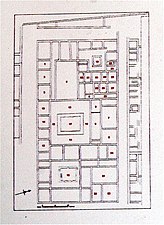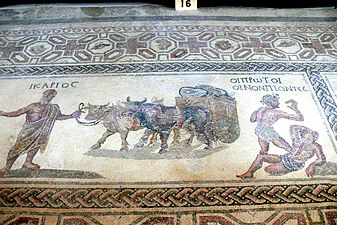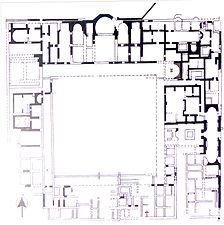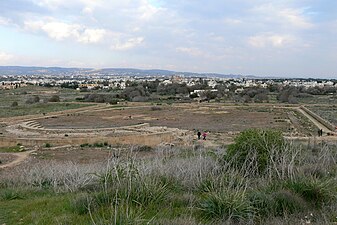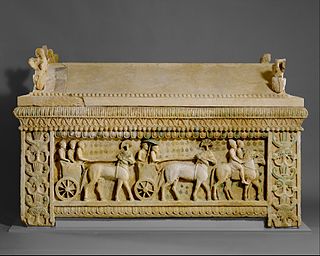
Amathus or Amathous was an ancient city and one of the ancient royal cities of Cyprus until about 300 BC. Some of its remains can be seen today on the southern coast in front of Agios Tychonas, about 24 miles (39 km) west of Larnaca and 6 miles (9.7 km) east of Limassol. Its ancient cult sanctuary of Aphrodite was the second most important in Cyprus, her homeland, after Paphos.

Salamis was an ancient Greek city-state on the east coast of Cyprus, at the mouth of the river Pedieos, 6 km north of modern Famagusta. According to tradition, the founder of Salamis was Teucer, son of Telamon, king of the Greek island of Salamis, who could not return home after the Trojan War because he had failed to avenge his brother Ajax.

Paphos is a coastal city in southwest Cyprus and the capital of Paphos District. In classical antiquity, two locations were called Paphos: Old Paphos, today known as Kouklia, and New Paphos.

Kazimierz Józef Marian Michałowski was a Polish archaeologist and Egyptologist, art historian, member of the Polish Academy of Sciences, professor ordinarius of the University of Warsaw as well as the founder of the Polish school of Mediterranean archaeology and a precursor of Nubiology.

Dion is a village and municipal unit in the municipality of Dion-Olympos in the Pieria regional unit, Greece. It is located at the foot of Mount Olympus at a distance of 17 km from the capital city of Katerini.

Zeugma was an ancient Hellenistic era Greek and then Roman city of Commagene; located in modern Gaziantep Province, Turkey. It was named for the bridge of boats, or zeugma, that crossed the Euphrates at that location. Zeugma Mosaic Museum contains mosaics from the site, and is one of the largest mosaic museums in the world.
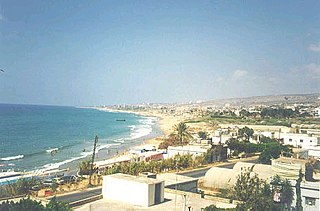
Jieh is a seaside town in Lebanon with an estimated population of 5000, 23 km south of Beirut, in the Chouf district via a 20-minute drive along the Beirut to Sidon highway south of the capital. In Phoenician times it was known as Porphyreon and was a thriving natural seaport, which still functions today. The town is also known for its seven kilometre sandy beach, a rarity along Lebanon's mainly rocky coastline.

Arycanda or Arykanda is an Ancient Lycian city, former bishopric and present Catholic titular see in Antalya Province in the Mediterranean Region of Turkey.

Littlecote Roman Villa is an extensive and exceptional Roman villa, with associated religious complex, at Littlecote Park just over a mile west of Hungerford, Berkshire. It has been excavated and is on display to the public in the grounds of the estate.
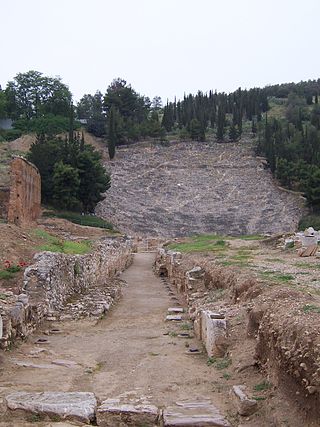
The Archaeological Museum of Argos is a museum in Argos, in Argolis on the Peloponnese peninsula, Greece. The history of the museum began in April 1932, when the heirs of J. Kallergis donated the building to the Argos city council. They in turn gave it to the Greek state along with the surrounding area on October 25, 1955.

Prusias ad Hypium was a city in ancient Bithynia, and afterwards in the late Roman province of Honorias. In the 4th century it became a bishopric that was a suffragan of Claudiopolis in Honoriade. Before its conquest by King Prusias I of Bithynia, it was named Cierus or Kieros and belonged to the Heraclea Pontica. Photius writes that it was called Kieros, after the river which flows by it.

A Roman mosaic is a mosaic made during the Roman period, throughout the Roman Republic and later Empire. Mosaics were used in a variety of private and public buildings, on both floors and walls, though they competed with cheaper frescos for the latter. They were highly influenced by earlier and contemporary Hellenistic Greek mosaics, and often included famous figures from history and mythology, such as Alexander the Great in the Alexander Mosaic.
Kom El Deka, also known as Kom el-Dikka, is a neighborhood and archaeological site in Alexandria, Egypt. Early Kom El-Dikka was a well-off residential area, and later it was a major civic center in Alexandria, with a bath complex (thermae), auditoria, and a theatre. Today, Kom el-Dikka is the largest and most complete above ground archeological site in Alexandria. It provides large amounts of archeological evidence of urban life in Roman Egypt, including early villas and their mosaics, and late Roman public works.

Roman Cyprus was a small senatorial province within the Roman Empire. While it was a small province, it possessed several well known religious sanctuaries and figured prominently in Eastern Mediterranean trade, particularly the production and trade of Cypriot copper. The island of Cyprus was situated at a strategically important position along Eastern Mediterranean trade routes, and had been controlled by various imperial powers throughout the first millennium BC. including: the Assyrians, Egyptians, Persians, Macedonians, and eventually the Romans. Cyprus was annexed by the Romans in 58 BC, but turbulence and civil war in Roman politics did not establish firm rule in Cyprus until 31 BC when Roman political struggles ended by Battle of Actium, and after about a decade, Cyprus was assigned a status of senatorial province in 22 BC. From then until the 7th century AD, Cyprus was controlled by the Romans. Cyprus officially became part of the Eastern Roman Empire in 293 AD.
Shhiim alternatively written as Shheem or Chhim/Shleem is a town in Lebanon which is located 40 kilometres south-east of Beirut. Shhiim is located on 4 mountains in the Chouf region in lebanon. Chhim has a population of about 49,000. It is considered a city by some.

Saranta Kolones is a ruined medieval fortress inside the Paphos Archaeological Park and it is located just north of the harbour of Paphos, on the island of Cyprus. It takes its name from the large number of granite columns that were found on the site and probably once formed part of the ancient agora. The Byzantine castle is believed to have been built at the end of the 7th century AD to protect the port and the city of Nea Pafos from Arab raids and later remodeled by the Lusignans. The Fortress had a three-metre thick wall with four huge corner towers and another four intermediary towers along the joining walls and moat surrounding the castle. Access was across a wooden bridge spanning the moat. The square courtyard measured 35 metres long by 35 metres wide, with a tower at each corner. The main entrance was through a fifth, horseshoe-shaped tower on the east side. Destroyed by an earthquake in 1222, the castle was subsequently abandoned. In modern times a series of excavations have taken place.
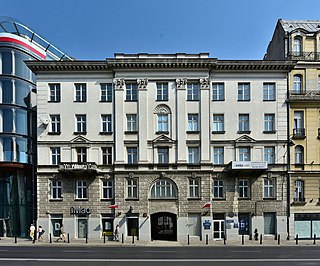
The Polish Centre of Mediterranean Archaeology University of Warsaw operates as an independent research institute of the University of Warsaw under the present name since 1990. It is dedicated to organizing, implementing and coordinating archaeological research, both excavations and study projects, as well as conservation, reconstruction and restoration projects, in northeastern Africa, the Near East and Cyprus. Projects include sites covering a broad chronological spectrum from the dawn of civilization through all the historic periods of the ancient Mediterranean civilizations to Late Antiquity and early Islam. Tasks beside fieldwork include comprehensive documentation of finds, archives management and publication of the results in keeping with international research standards. The PCMA manages the Research Centre in Cairo and Polish Archaeological Unit in Khartoum.

The mosaics of Delos are a significant body of ancient Greek mosaic art. Most of the surviving mosaics from Delos, Greece, an island in the Cyclades, date to the last half of the 2nd century BC and early 1st century BC, during the Hellenistic period and beginning of the Roman period of Greece. Hellenistic mosaics were no longer produced after roughly 69 BC, due to warfare with the Kingdom of Pontus and the subsequently abrupt decline of the island's population and position as a major trading center. Among Hellenistic Greek archaeological sites, Delos contains one of the highest concentrations of surviving mosaic artworks. Approximately half of all surviving tessellated Greek mosaics from the Hellenistic period come from Delos.

The Archaeological Park of Dion is the most important archaeological site at Mount Olympus in Greece, located in Dion. In the area comprised by the Archaeological Park of Dion, sanctuaries were found from the Hellenistic and Roman periods. The park displays the importance of ancient Dion in the history of Pieria.
The archaeology of Cyprus involves the analysis of human activity derived from Cypriot artefacts and architecture from the Neolithic through to the British period. The earliest archaeological discoveries in Cyprus are attributed to European amateur collectors or “treasure hunters” during the early 19th century. By the mid 19th century, systematic fieldwork and excavations were conducted on various sites involving studying the remains of Cypriot cemeteries and tombs, maritime artefacts, architecture, pottery as well as a range of other individual artefacts. Subsequent findings and analysis detail the social and physical landscapes of ancient Cyprus as well as their evolving culture, religious beliefs and technology throughout antiquity.


